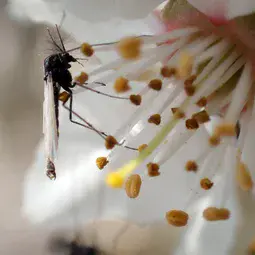Flies grow bigger up north: insect size a promising new proxy for palaeoclimate
29 April 2021
MUNICH — Scientists use many proxies to reconstruct Earth’s ancient climates. Pollen, diatoms, geochemical isotopes, and fossils, for example, all contribute to piecing together past-climate puzzles. The ubiquity and wide geographic range of insects—like the nonbiting midge (Order Diptera, Family Chironomidae), a type of fly—have made them a useful tool to reconstruct palaeoclimates around the world during the recent geologic past.
Previous research used chironomids to reconstruct climate during the Holocene (roughly the past 11,000 years), comparing the fossil insects to modern midges. “This [technique] is pretty good, but it has a major drawback: the further back in time you go, the less applicable what we know about the coverage of modern animals becomes,” says Viktor Baranov, a palaeontologist at Lüdwig Maximilians-University in Munich. For example, the small dragonflies of today might not have shared a similar range with the metre-long dragonflies of the Cretaceous around 100 million years ago, he explains.
Now, Baranov and his team have developed a technique to reach back in time, using the size of fossil midge bodies and wings to reconstruct temperatures all the way back to the start of the Cretaceous about 145 million years ago. Baranov says they wanted to add a proxy that can be useful for fossils that are found in geologic settings where other proxies might be unusable. Their results, presented at the European Geosciences Union (EGU) General Assembly 2021, show the relation of insect body size to latitude appears to be a promising new proxy for palaeotemperatures.
The possibility of using insects for palaeoclimate work deep in the geologic past was alluring, and Baranov says that he started looking at literature to see if it might be feasible. “I noticed that some workers wrote down in very old papers anecdotal evidence—it appears that the Afrotropical representative of this genus living in the Congo seems to be considerably smaller than close relatives from France,” Baranov says.
Considering that Bergmann’s rule, which holds that animals like polar bears or Amur tigers that live in the Arctic are large-bodied animals, whereas their cousins in the tropics are small, Baranov thought “there might be a similar reliable, quantitative relationship between body size and temperature” of fossilised midges. To test his theory, he needed to start measuring insects.
Measuring Many Midges
The omnipresence of insects makes them a good candidate to reveal global patterns, Baranov says. The “collection in Munich alone has about 2 million specimens of chironomids, from Antarctica to the Arctic, from Australia to England.”
The team looked at 6,300 specimens that lived at some time between the Triassic (245 million years ago) and today, with good geographic location information. They measured body and wing lengths, finding that, in Northern Hemisphere chironomids, both became larger the more northward their range. This means that, like polar bears, the midges got bigger with colder temperatures.
“The average midge becomes one millimetre longer per every five degrees of latitude,” Baranov says. “That was very exciting for me to learn. Because it means there seems to be a very strong signal, at least in this group.”
The results show the potential of using invertebrate fossils for quantitative analyses to reconstruct palaeotemperatures over millions of years, Baranov says.
Additionally, this temperature-size relationship might be useful in predicting what could happen to modern insect populations facing climate change. “I’m also working on the insect decline and drivers of the modern insect extinctions,” Baranov says. “It appears that increasing temperatures influence insect size, and that’s impacting their ability to fly around.”
More information
When reporting on this story, please mention the EGU General Assembly 2021, which is taking place from 19-30 April 2021. This paper will be presented in session SSP4.3 on Thursday, 29 April, 15:30-17:00 CEST. If reporting online, please include a link to the abstract: https://doi.org/10.5194/egusphere-egu21-9134
Press release text by Sarah Derouin
Contact
Terri Cook
EGU Head of Media, Communications, and Outreach
Munich, Germany
Emailmedia@egu.eu

